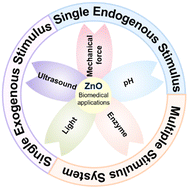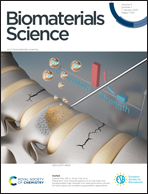Research progress of stimuli-responsive ZnO-based nanomaterials in biomedical applications
Abstract
Zinc oxide nanoparticles (ZnO NPs), an attractive oxide semiconductor material, are widely used in the biomedical field due to their good biosafety and economy. The proposal of stimuli-responsive materials provides a new way for the further application of single ZnO-based nanomaterials that cannot meet the ever-changing requirements. In this review, the emerging advances in exogenous stimuli (light, ultrasound, mechanical force, etc.) and endogenous stimuli (pH, enzymes, etc.) responsive systems of ZnO-based nanomaterials in biomedical applications are highlighted. First, the basic characteristics, response mechanisms and construction principles of single-stimulus-responsive ZnO-based nanomaterials, as well as their recent advances in tissue repair, medical devices and theranostics are summarized. Subsequently, the design method of multi-stimuli-responsive ZnO-based biomaterials is discussed, and the application advantages of multi-functional responsive systems are explained by analyzing typical cases of biomedical applications of multi-responsive strategies. Finally, we discuss the prospects for the design and development of stimuli-responsive ZnO-based biomaterials for biomedical applications and point out their advantages as well as the places that need to be further improved. The current review may provide a useful reference for researchers interested in constructing such abundant, inexpensive and widely applicable multi-stimuli-responsive materials.

- This article is part of the themed collection: Biomaterials Science 10th Anniversary Collection


 Please wait while we load your content...
Please wait while we load your content...